Where Are You Headed?
When you have a clear vision and path to where you want to go, possibilities become more real. When you become committed, you become unstoppable.
This guide is designed to provide you the opportunity to get crystal clear on what it is that you really want for yourself and to support you on your journey to live a healthy and fulfilling life designed by YOU. Step out and live BIG – otherwise those dreams will simply remain wishes!
Why Set Goals?
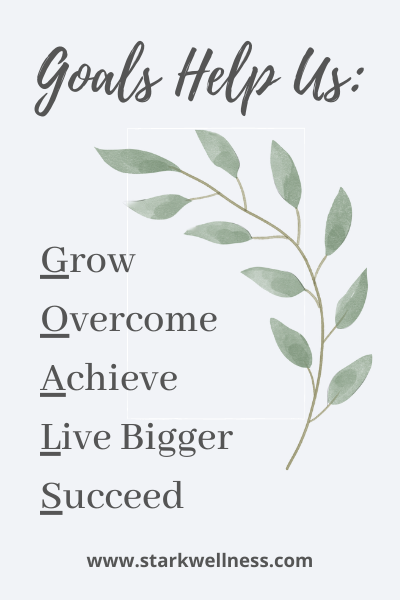
Goals help us Grow, Overcome, Achieve, Live Bigger, and Succeed.
Goals keep us from becoming stagnant, bored and unhappy with our lives.
Goal setting is the number one way to start creating a life you love.
Most everyone has at least one goal that is top of mind. Oftentimes, though, goals are more like distant wishes – thoughts of ’maybe’ or ‘someday’ or ‘if only things were different, then’….
What if your goals were more within your reach than you thought?
What is it that you ultimately want to achieve?
Consider all the goals you may have related to your health, fitness and well-being. What lifestyle, career, relationship or spiritual goals have you contemplated? How will those goals get you where you want to go? How will your life look when you achieve all your goals?
This is your opportunity to dig deep and focus on what you really want so you can set goals and map out your plans to reach them.
Though not necessary, I recommend grabbing a large glass of fresh habiscus tea (or any other delicious drink), your favorite pen, and a sheet of paper or a journal. You could also download my Holistic Wellness Inventory and Goal Setting Worksheet. It will make this extra fun!
Writing your goals down on paper is a powerful way to set an intention and begin the process of formulating your plan. When your goals are written down, you’ll have a much higher chance of reaching them.
Don’t skip this step because this is where you get to start designing your future.
“People with clear, written goals, accomplish far more in a shorter period of time than people without them could ever imagine.” – Brian Tracy (a leader in self-development)
Of course, there’s more to it than just writing them down.
Taking the time to go through this goal setting process may make the difference in finally achieving all that you desire.
I am a dreamer. I like that about me. But….when I REALLY want to accomplish something, I’ve got go through a process like this to reign myself in, focus my attention, and achieve my big dreams.
Are you ready to get started?
Goal Setting
First, clarify your goals.
Get clear on what it is you’re striving for so that you set meaningful goals. The best place to start is to identify your end result, or destination.
Where do you want to be? What is it that you want to achieve? What areas of your health and life are out of balance and what would bring balance?
For example, you may say that your goal is to be healthy. That could mean many things. Until you define what “healthy” means for you, your goal is pretty vague. However, if you determine that being healthy means having a strong immune system, having energy and vitality, being fit, managing your weight, being off prescriptions, feeling great, or looking youthful, you now know what healthy means to you – being healthy is the destination.
Next, explore your why.
Why do you want to be healthy or where you want to be? Will it change your life somehow? Will it help you be able to do or experience something specific? Is it the first step to accomplishing something even bigger or opening another door of opportunity?
Finally, acknowledge where you’re starting from.
What are your current circumstances regarding your goal? Are you starting from scratch, or taking on a brand new endeavor? In what ways are you already succeeding and moving towards your goal?
Honor your current state and successes rather than putting yourself down. Even if you have a goal to do something for the first time–like catch a wave–acknowledge and celebrate your shoulder strength or your bravery in the sea.
It can be helpful to develop a scale to score your current success and progress.
For example, if you want to become more organized, how would you score yourself now on a scale from 1-10 if 1 means you are an absolute mess and your life is in total disarray, and 10 means everything in your life is perfectly organized.
Actually, you get to determine what a 10 means for YOU. Whatever your goal is, you define the destination; then consider how close you are now.
Once you’re clear on these three things, you can set your goals to get to your destination, and that starts with looking at….
Priorities
Next, look at your priorities – the things that are important to you and to which you are committed. Being clear on your priorities will serve as your personal GPS to keep you on the right path.
Honoring priorities makes decisions easier.
When a difficult decision presents itself, recognizing and choosing your best options will be easier when you are clear on your values and priorities.
Think about your current priorities. Is there something that needs to shift or change to help you reach your goals?
If your priorities aren’t in line with your goals, it’s going to be a struggle to reach them and you’re going to create more stress in your life.
Let’s say family, health and fitness are your top 3 priorities AND you’re looking for a new job. If you’re offered a job that requires a lot of travel, that job may not fit in with those goals. Consider that extensive business travel would mean you wouldn’t be home much with your family, exercising could be much more challenging, and the commute could take a toll on your health.
If, on the other hand, you’re offered a job where you can work at home more, or have a shorter commute and still make good money doing something you enjoy, this job offer would be a better fit based on your priorities.
However, for someone who is single and lists things like adventure, travel and career as their top priorities, the job offer that requires a lot of travel may be a great fit, whereas they might feel stagnant working from home and spending all their days in their own town.
Choices depend on priorities and life’s circumstances. When your priorities are in line with your goals, you’ll be able to formulate a clearer path and reach those goals sooner.
Action Step: List all your priorities and then star, highlight or rewrite your top 5.
Here are some ideas to get you started: yourself, family, friends, health, fitness, nourishment, spirituality, education, finances, career, freedom, adventure, travel, security, romance, cleanliness, order, tidiness, comfort, pleasure, joy, productivity, service, contribution, ease, flow
These are just a few suggestions, so write whatever yours are. While you don’t have to stop at five, if you have too long of a list you may end up with competing priorities.
And…..
Where are YOU in the list?
You deserve abundant health and happiness and you deserve to feel energetic and amazing! This means putting yourself high on your list if you’re not already there.
When you’re taking care of yourself, everything is easier, you feel so much better, and you have more to give.
If you’re too busy taking care of everyone else, how will you find the time to take care of YOU? If you don’t take care of you now, who is going to take care of your loved ones later?
Who do you need help or support from in order to put yourself near the top?
For example: if your priority is fitness and you plan to exercise in the morning, do you need help or support from your spouse and/or children to make that happen?
Be SMART About Your Goals
Some people enjoy setting goals using the SMART method as a basis for a personal map to success:
S – Specific – this is the WHAT, WHY and HOW of the goal. Focus in on WHAT you really want, WHY it’s important to you, and HOW you plan to achieve it. (If you aren’t quite sure right now, it’s okay – you will figure this out as you work through this process). For now, the HOW can be HOW you see setting time aside to focus on your goal.
M – Measurable – how will you measure your progress? The best way to track your progress is to measure it tangibly. From a health or weight loss perspective, it may be helpful to weigh-in on a schedule, like once or twice a month and take body measurements once a month. You may want to see certain lab results reach healthier levels. You may have physical accomplishments you wish to achieve to show you’re getting stronger or increasing your cardiovascular capacity or endurance. These examples have measurements or specific, tangible results.
A – Achievable – set a goal that is achievable but that also challenges or stretches you. Set short-term goals or milestones to mark your progress towards your long-term goals. If you are a new runner, becoming a marathon runner is only achievable after reaching a distance of 1K, 5K, 10K, and so on. If you can do 10 pushups at once, setting a goal to do 11 by the end of the year is not going to be much of a challenge for you, unless it’s already December.
R – Realistic – be realistic in creating your goals and your plan. For example, wanting to lose 25 pounds in one month is not realistic or desirable because it could be harmful. Ask for help or feedback if you’re unsure whether a goal is realistic or not. Sometimes we place unreasonable demands on ourselves that we would never expect from others, nor would they expect from us.
T – Time-bound – determine when you want to achieve your goal. This helps you know if your goal and your plan are realistic. It’s also helpful to have a time line to keep you on track with the milestones you set. (If your goal is weight loss, a time frame is good, but it’s also important to be aware that everyone loses weight at different rates and to not get discouraged if weight loss does not happen as quickly as you would like.) The other benefit of a timeline with milestones is that it gives you the opportunity to assess your progress and redefine your goals if necessary – they’re in writing and not set in stone!
Long Term and Short-Term Goal Setting
Start brainstorming your goals as if anything were possible! Dream big!
What do you want your life, your relationships, your health, your finances, your career to look like in one, three, or five years?
What do you want to achieve in the next six months?
You’ll want to set both long-term goals and short-term goals or milestones.
Be sure to write down your goals and put them somewhere you will see them often: a note on your bathroom mirror, office desk, in your planner, or on your phone are handy places. I keep mine in my planning notebook that I look at every day.
There are also apps that will even send you reminders, which can be helpful. A few goal setting apps include: AwesomeNote, Toodledo, 2Do and Goal Achiever.
Don’t worry about knowing the exact ‘HOW’ right now, just write them down.
Here’s my narrowed down list of top priorities and goals following this guide:
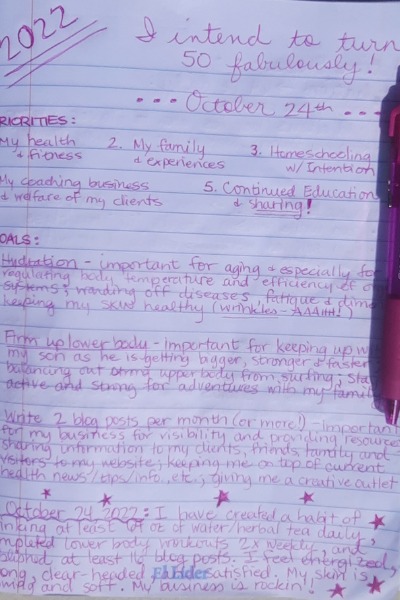
And, here’s how I used the first page of my Holistic Wellness Inventory and Goal Setting Worksheet to complete the exercise:
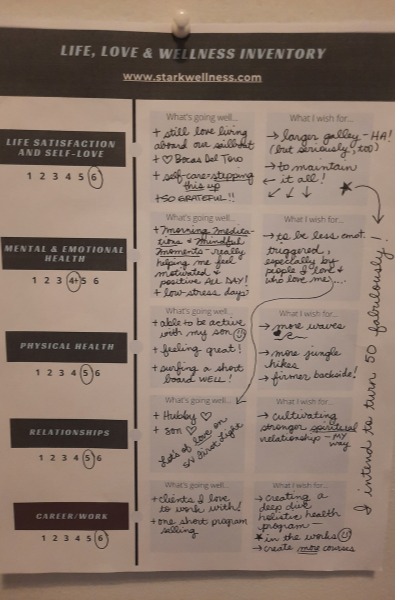
You’ll see my plans for HOW at the end of this guide.
Be Specific
When you are figuring out your goals, be as specific about your vision as possible. Develop a clear mental picture of your goals; the more laser-focused you can get, the better.
I’ll share an example of setting a financial goal:
Instead of having a goal of “saving money” each month, get very specific. What dollar amount do you want to save each month and how can you make that happen? Determine your why and determine if the goal is attached to one of your priorities. Are you saving a certain amount each month (short-term goals) in order to purchase something great in the future, or reach a retirement goal (long-term goals)? Also, identify the point from which you’re starting. What could you already contribute to your stash? If you are starting with $0, celebrate your work ethic, resourcefulness, or creativity that will lead to the savings.
Here is an example for a specific financial goal and a clear destination: a vision for a family vacation:
“I will save money for a family Christmas vacation to Bocas Del Toro, Panama. This year we are prioritizing creating family memories. We have longed to visit a world class surf destination and would enjoy a warm, tropical holiday for once. Since we will need $4,000 and have no savings, I will set up an automatic transfer of $400 from my monthly paycheck into a special savings account for ten months.”
This example is Specific, Measurable, Achievable, Realistic and Time Bound. It also ties into the priorities of my family as well as personal priorities for fun and adventure.
By the way….my family actually lives aboard a sailboat in Bocas Del Toro, Panama. We really made that dream happen in a BIG way. We sold a house and saved up money. We set a goal to create a life we love, not just take a vacation, but we had a series of milestones to plan out and achieve just the same. If you would like a tropical retreat, get in touch!
Action Step:
Try your hand at writing out long-term and short-term SMART goals. Write out 1-5 goals for yourself, and then get your spouse and/or family involved in some goal-setting if you want to. Make it fun!
Your Why
Why do you want to reach your goals? What would that really mean to you and what would that feel like?
If you don’t have an emotional attachment to your goals, they aren’t usually as meaningful or motivating. Your “why” is what will help you stay committed when achieving your goal seems hard or challenging.
What’s going to get you moving on those days you really don’t ‘feel like’ it?
Maybe you have a goal to lose 20 pounds to fit into a dress for an event. Why is that important? Truth is, it’s probably not about the dress. It’s most likely about how you will feel: more confident, or more care-free on the dance floor perhaps.
Your why is usually layers underneath your initial answer.
Action Step: Figuring Out Your Why
Do this WHY exercise for each goal so that it becomes a driving force for you rather than just a wish.
I have a goal to ……
because ……
This is important to me because ……
and I want to ……
and I want to feel like ……
because ……
and this would mean ……
(Yes, I know there are a few “because” spaces in there. That’s the most important part in getting to your WHY).
Putting the Pieces Together and Making a Plan
So, you’ve looked at your top priorities, written down your long-term and short-term SMART goals, and you’ve figured out your compelling WHY. Awesome!
Now it’s time to map out how to put your plans in place.
Take some time to work backwards on this. By working backwards from the destination and end date to today, you can figure out what needs to be done by when. This gives you a concrete timeline from which to work and live by. Start brainstorming and create your plan.
Example: If your goal is to earn or save $600 within 6 months, what do you need to start putting into place NOW? If your goal is to lose 30 pounds in 6 months, what is your 6 month plan?
Brainstorm some actions you can take, short-term and long-term, to reach your goal?
Don’t limit yourself by not listing things you think aren’t possible. Just write them down.
What if anything were possible, what would you set for your goals?
Be as specific as you can continuing to use the SMART formula; and it’s a great idea to use the present tense.
Example: “I have lost 10 pounds” or “I have paid off one credit card”.
Include areas such as: health, fitness, finances, relationships, career, education, travel, spirituality, etc.
Action Step: For each goal you have write out the actions you will take to reach your goal.
Follow the example and what you’ve learned to list 3-5 actions you will take within each of the following time frames:
- 1 YEAR FROM NOW
- 6 MONTHS FROM NOW
- 3 MONTHS FROM NOW
- 1 MONTH FROM NOW
Decide one action you can take TODAY to begin to put this plan in motion? What is the first step, the easiest action, the quickest win, or the most appropriate?
What is another action you can take this week?
Grab a planner or calendar, or get an app like AwesomeNote, 2Do, or Toodledo (there are many others too) to set specific goals and help keep you organized and on track.
Having an initial time frame for when you’d like to accomplish your goals will drive you towards reaching them sooner. We all work smarter when we have a deadline. Adjust tasks and due dates as needed.
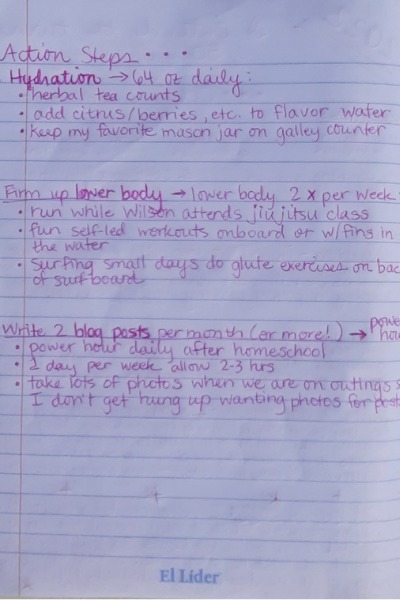
Here’s how I used the second page of my Holistic Wellness Inventory and Goal Setting Worksheet to complete this exercise:
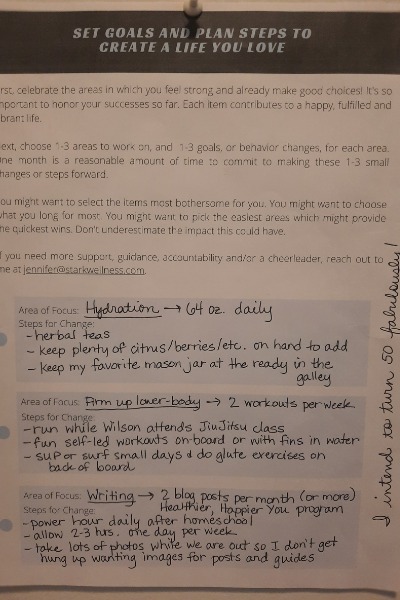
Once more, go back over your list of priorities, your WHY and your SMART goals and be sure your goals are in sync with what you really want for your life.
How do you really want to spend your time? What makes you happiest? Are your goals in line with that? If yes, that’s great – you’re on your way. If they’re not, just take some time to reevaluate what’s most important to you at this time in your life and adjust your goals and your plan accordingly.
Once your goals are in line with your priorities, you have a solid plan in place and you know what you want, deep down inside, you become unstoppable!
Keep your goals in front of you often as this will guide you in the direction you want to go.
What you focus on is what you get.
What will you start with TODAY?
“Your goals are the road maps that guide you and show you what is possible for your life.” Les Brown

Hi! I’m Jennifer, your life, love and wellness coach! I help men, women and couples figure out what’s keeping them from being happy and healthy so they can overcome those blocks and determine and implement steps to truly improve their lives, relationships, and physical and mental health. I’m a certified Professional Life Coach and Holistic Health Coach with a background in professional counseling. I’m ready to help you. jennifer@starkwellness.com
Hey! Before you go, I’ve got a great tool to help you plan out your goals. It’s a Holistic Wellness Inventory and Goal Setting Worksheet. Scroll on down, or check it out in the side-bar if your on a PC.
[…] You also might enjoy reading: “Your Guide to Supercharged Goal Setting” […]